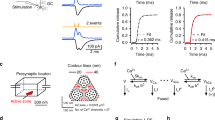Summary
Different synaptic terminals of the single excitor axon to the opener muscle of crayfish (Procambarus clarkii) often release transmitter in a very different manner when stimulated with the same equal-interval, doublet, or triplet patterns. Compared to synapses that show little facilitation (low Fe synapses), highly facilitating (high Fe) synapses show greater percentage increases in several measures of synaptic efficacy when stimulated with any of these patterns. Low Fe synapses usually show the greater absolute changes in these measures of synaptic efficacy. Changes in the span and pattern of doublets and triplets can independently affect both pre- and postsynaptic measures of synaptic efficacy at either low Fe or high Fe synapses.
Similar content being viewed by others
Abbreviations
- EJP :
-
excitatory junctional potential
- MJP :
-
spontaneous miniature EJP
- F e :
-
ratio of EJP at 1 Hz to EJP amplitude at 10 Hz
- F 1 :
-
zero-time facilitation
- A 2,B 2,C 2 :
-
doubly corrected EJP amplitude of a particular pulse
- \(\overline {A_2 } ,\overline {A_2 + B_2 } ,\overline {A_2 + B_2 + C_2 } \) :
-
average amplitude of doubly corrected EJPs in a train of equal-interval, doublets, and triplets, respectively
- Am, Bm, Cm :
-
maximum depolarization reached by a particular EJP
- τ :
-
time constant of decay
References
Atwood HL, Bittner GD (1971) Matching of excitatory and inhibitory input to crustacean muscle fibers. J Neurophysiol 34:157–170
Atwood HL, Wojtowicz JM (1986) Short-term and long-term plasticity and physiological differences of crustacean motor synapses. Int Rev Neurobiol 28:275–362
Baxter DA, Bittner GD, Brown TH (1985) Quantal mechanisms of long-term potentiation. PNAS 82:5978–5982
Bittner GD (1968a) Differentiation of nerve terminals in the crayfish opener muscle and its functional significance. J Gen Physiol 51:731–758
Bittner GD (1968b) The differentiation of crayfish muscle fibers during development. J Exp Zool 167:439–456
Bittner GD, Harrison J (1970) A reconsideration of the Poisson Hypothesis for transmitter release at the crayfish neuromuscular junction. J Physiol 206:1–23
Bittner GD, Sewell VL (1976) Facilitation at crayfish neuromuscular junctions. J Comp Physiol 109:287–308
Charlton MP, Bittner GD (1978) Facilitation of transmitter release at squid synapses. J Gen Physiol 72:471–486
Del Castillo J, Katz B (1954) Statistical factors involved in neuromuscular facilitation and depression. J Physiol 124:574–585
Dudel J, Kuffler SW (1961) Mechanism of facilitation at the crayfish neuromuscular junction. J Physiol 155:530–542
Frank E (1973) Matching of facilitation at the neuromuscular junction of the lobster: a possible case for the influence of muscle on nerve. J Physiol 233:635–658
Katz B (1966) Nerve, muscle, and synapse. McGraw-Hill, New York
Linder TM (1974) The accumulative properties of facilitation at crayfish neuromuscular synapses. J Physiol 238:223–234
Lnenicka GA, Blundon JA, Govind CK (1988) Early experience influences the development of bilateral symmetry in a lobster motoneuron. Dev Biol 129:84–90
Mallart A, Martin AR (1967) An analysis of facilitation of transmitter release at the crayfish neuromuscular junction. J Physiol 193:679–694
Martin AR (1955) A further study of the statistical composition of the end plate potential. J Physiol 130:114–122
Segundo JP, Perkel DH (1969) The nerve cell as analyzer of spike trains. In: Brazier MAB (ed) The interneuron. University of California Press, Los Angeles, pp 349–390
Segundo JP, Moore GP, Stensaas J, Bullock TH (1963) Sensitivity of neurones inAplysia to temporal pattern of arriving impulses. J Exp Biol 40:643–667
Smith DO (1974) Central nervous control of excitatory and inhibitory neurons of the opener muscle of the crayfish claw. J Neurophysiol 37:108–118
Taraskevich PS (1971) Reversal potentials of L-glutamate and the excitatory transmitter at the neuromuscular junction of the crayfish. Biochem Biophys Acta 241:700–703
Wiens TJ (1984) Triple innervation of the crayfish opener muscle: the Astacuran common inhibitor. J Neurobiol 16:183–191
Wiersma CAG, Adams RT (1950) The influence of nerve impulse sequence on the contractions of different crustacean muscles. Physiol Comp Oecol 2:20–23
Wilson DM, Davis WJ (1965) Nerve impulse patterns and reflex control in the motor system of the crayfish claw. J Exp Biol 43:193–210
Wilson DM, Larimer JL (1968) The catch property of ordinary muscle. PNAS 61:909–916
Zucker RS (1974) Characterization of crayfish neuromuscular facilitation and their calcium dependence. J Physiol 241:91–110
Author information
Authors and Affiliations
Rights and permissions
About this article
Cite this article
Bittner, G.D., Segundo, J.P. Effects of stimulus timing on transmitter release and postsynaptic membrane potential at crayfish neuromuscular junctions. J. Comp. Physiol. 165, 371–382 (1989). https://doi.org/10.1007/BF00619356
Accepted:
Issue Date:
DOI: https://doi.org/10.1007/BF00619356




